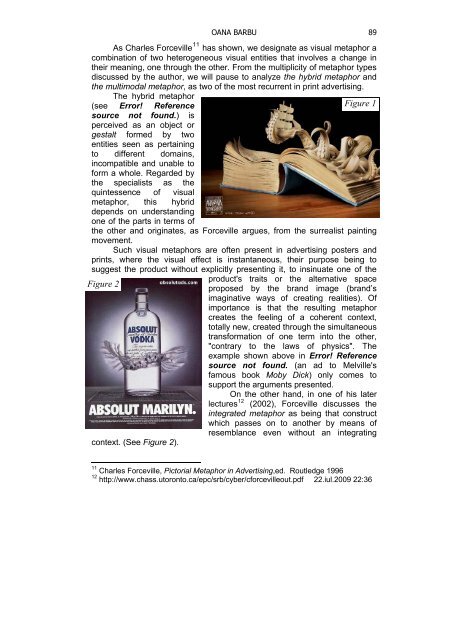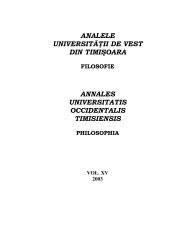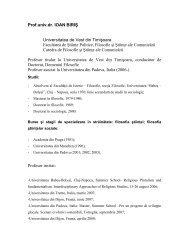VOL. IV (XXI) 2009 - Departamentul de Filosofie si Stiinte ale ...
VOL. IV (XXI) 2009 - Departamentul de Filosofie si Stiinte ale ...
VOL. IV (XXI) 2009 - Departamentul de Filosofie si Stiinte ale ...
You also want an ePaper? Increase the reach of your titles
YUMPU automatically turns print PDFs into web optimized ePapers that Google loves.
OANA BARBU 89<br />
As Charles Forceville 11 has shown, we <strong>de</strong><strong>si</strong>gnate as visual metaphor a<br />
combination of two heterogeneous visual entities that involves a change in<br />
their meaning, one through the other. From the multiplicity of metaphor types<br />
discussed by the author, we will pause to analyze the hybrid metaphor and<br />
the multimodal metaphor, as two of the most recurrent in print adverti<strong>si</strong>ng.<br />
The hybrid metaphor<br />
(see Error! Reference<br />
Figure 1<br />
source not found.) is<br />
perceived as an object or<br />
gestalt formed by two<br />
entities seen as pertaining<br />
to different domains,<br />
incompatible and unable to<br />
form a whole. Regar<strong>de</strong>d by<br />
the specialists as the<br />
quintessence of visual<br />
metaphor, this hybrid<br />
<strong>de</strong>pends on un<strong>de</strong>rstanding<br />
one of the parts in terms of<br />
the other and originates, as Forceville argues, from the surrealist painting<br />
movement.<br />
Such visual metaphors are often present in adverti<strong>si</strong>ng posters and<br />
prints, where the visual effect is instantaneous, their purpose being to<br />
suggest the product without explicitly presenting it, to in<strong>si</strong>nuate one of the<br />
product's traits or the alternative space<br />
proposed by the brand image (brand’s<br />
imaginative ways of creating realities). Of<br />
importance is that the resulting metaphor<br />
creates the feeling of a coherent context,<br />
totally new, created through the <strong>si</strong>multaneous<br />
transformation of one term into the other,<br />
"contrary to the laws of phy<strong>si</strong>cs". The<br />
example shown above in Error! Reference<br />
source not found. (an ad to Melville's<br />
famous book Moby Dick) only comes to<br />
support the arguments presented.<br />
On the other hand, in one of his later<br />
lectures 12 Figure 2<br />
(2002), Forceville discusses the<br />
integrated metaphor as being that construct<br />
which passes on to another by means of<br />
resemblance even without an integrating<br />
context. (See Figure 2).<br />
11 Charles Forceville, Pictorial Metaphor in Adverti<strong>si</strong>ng,ed. Routledge 1996<br />
12 http://www.chass.utoronto.ca/epc/srb/cyber/cforcevilleout.pdf 22.iul.<strong>2009</strong> 22:36




